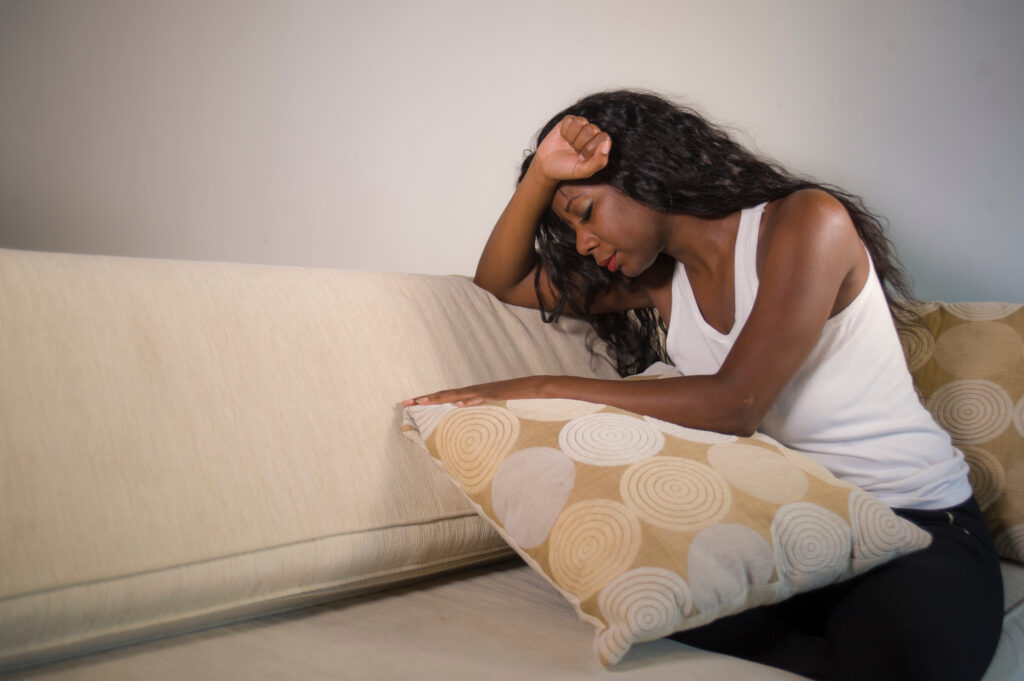
Anxiety and depression are listed independently in the Diagnostic and Statistical Manual for Mental Disorders (DSM); there is a solid and notable link between these mental health conditions. Although it is possible and not uncommon to receive a diagnosis of either anxiety or depression, it is also equally likely to struggle with both conditions simultaneously. Depression and anxiety frequently co-occur, meaning someone experiences the complex symptoms of both conditions at the same time, making each even more difficult and challenging to manage.
There is a unique and complicated link between anxiety and depression. When someone has anxiety, they are at an increased risk of developing depression. In fact, some studies show up to half of those who have major depression also experience persistent, severe anxiety. Also, depression causes emotions such as fear and worry. When you are frequently worried about something (regardless of how significant that “something” might be), it can trigger anxiety. If you or a loved one are struggling with an anxiety disorder, it is crucial to seek help from a mental health treatment center like The Meadowglade before your symptoms have the opportunity to evolve into a more complex, co-occurring disorder. Knowing if you need to or should consider seeking help is best achieved by understanding what anxiety and depression are and what the symptoms of each condition may look like in a friend or loved one.
What is Anxiety?
When you have anxiety, it is more than moments of worry or fear. An anxiety disorder is a chronic, persistent cluster of emotions that interferes with daily functioning. For many, symptoms of anxiety begin as early as childhood and continue into adulthood. As previously mentioned, anxiety is not a standalone diagnosis like having the flu. The Diagnostic and Statistical Manual for Mental Disorders (DSM) lists several anxiety diagnoses, including separation anxiety, phobias, generalized anxiety disorder, and social anxiety disorders. Any type of anxiety is best managed by seeking professional help at an anxiety treatment center so you can safely overcome anxiety and leave treatment with the tools and skills necessary to cope with triggers in a safe and healthy way.
According to the National Alliance on Mental Illness (NAMI), anxiety disorders affect up to 19% of the 40 million American adults over eighteen in the United States. This makes anxiety disorder the most common mental health diagnosis in America. Like other mental health conditions and , anxiety and depression are treatable, yet many do not seek the help they need. The Anxiety and Depression Association of America (AADA) suggests less than 37% of people with anxiety disorder get treatment.
Types of Anxiety
The Diagnostic and Statistical Manual for Mental Disorders (DSM) provides specific diagnostic criteria mental health providers use to assess and diagnose mental health conditions properly. The DSM lists multiple potential anxiety diagnoses; however, five are among the most familiar and widely diagnosed.
Generalized Anxiety Disorder
Someone with a generalized anxiety disorder (GAD) struggles with chronic anxiety symptoms. They often feel on guard or excessive worry and tension, even in the absence of a reason to feel afraid.
Obsessive-Compulsive Disorder (OCD)
Someone OCD experiences recurrent and unwanted thoughts, also referred to as obsessions coupled with repetitive behaviors or compulsions. Repetitive behaviors may include activities like cleaning, handwashing, counting, and checking. Compulsive behaviors are performed because they are believed to reduce the intensity and severity of obsessions. Unfortunately, compulsions only provide limited and temporary relief, although they cause significant interference with the person’s day-to-day life and obligations. But, because failure to perform them often leads to excessive anxiety, they are performed without fail.
Panic Disorder
Someone with a panic disorder will experience recurring and unwanted episodes of overwhelming, often paralyzing fear. Fear is typically accompanied by other physical symptoms such as breathing problems, stomach problems, racing heart, etc.
Post-Traumatic Stress Disorder (PTSD)
Post-traumatic stress disorder often occurs after someone has experienced or witnessed an event that causes harm (or the threat of harm). Common examples of possible trauma-inducing events include assault, violence, accidents, and natural disasters.
Social Phobias
Social phobias are also called social anxiety disorders. When someone has a social anxiety disorder, they feel uncontrollable anxiety, self-consciousness, and fear during social situations.
Symptoms of Anxiety
Anxiety is more than a singular diagnosis. It is a collection of diagnoses with both unique and common symptoms shared amongst them. The most common symptom seen in all anxiety disorders is chronic and abnormal fear in unthreatening situations—people with anxiety experience a range of emotional and physical symptoms. Physical symptoms experienced with anxiety may include racing heart, fatigue, sweating, difficulty breathing, sleeping problems, stomach problems, and headache. Emotional symptoms often include feelings of dread, being “jumpy,” hypervigilance, restlessness, and irritability.
Anxiety Disorder Causes and Risk Factors
Research has not provided a singular cause or risk factor that increases one’s risk for developing an anxiety disorder. Studies indicate it is likely a combination of several factors, including genetic and environmental elements. Some studies show that anxiety disorders have a genetic connection as some families have multiple individuals with anxiety disorders among relatives. Additionally, research shows that you are at an increased risk for developing anxiety if a first-degree relative struggles with an anxiety disorder.
Anxiety often arises out of environmental or social situations. Some research indicates you may be at an increased risk for developing an anxiety disorder if you experience a stressful or traumatic event. For example, violence, abuse, prolonged illness, or a natural disaster may lead to the development of anxiety.
What is Depression?
Feeling blue or “down in the dumps” is a normal human emotion from time to time. Everyone experiences moments of unhappiness or when they feel upset about a specific event or circumstance. These moments of sadness are frequently referred to as depression. For most, these feelings are only temporary. Often, they will resolve within a short window of time after the event or situation resolves. Clinical depression, or simply depression, is not temporary. When someone is depressed, they struggle with pervasive emotions that do not resolve independently from depression treatment.
In the mental health community, depression is often called clinical depression or major depressive disorder. When someone has depression, they struggle with powerful and overwhelming feelings of irritability, emptiness, and sadness. Usually, their symptoms are so intense they can limit or even wholly restrict one’s ability to function each day.
Although not the most common mental illness, depression affects one out of every fifteen American adults. This averages out to approximately 7% of people over age 18 every year. Also, up to 16% more will experience depression or receive a diagnosis of depression at some point in their lives. Although depression can occur at any time, it is most commonly diagnosed during one’s teens and early 20s. Depression is also seen more often in women than in men.
Types of Depression
The National Institute of Mental Health defines several different forms of depression. Each form of depression is slightly different and may develop under unique circumstances.
- Persistent depressive disorder is characterized by a state of depressed mood that lasts for at least two years. When someone is diagnosed with persistent depressive disorder, they may have episodes of major depression along with periods of less severe symptoms; however, depressive symptoms, regardless of severity, persist well beyond what is required for a major depression diagnosis.
- Psychotic depression is a form of depression that occurs when someone experiences severe depression symptoms plus some form of psychosis. This may include delusions, hallucinations, or other psychotic symptoms. Generally, psychotic symptoms often follow a depressive theme, such as false beliefs about illness, guilt, death, etc.
- Seasonal affective disorder is a form of depression that occurs during the winter months. For most, this form of depression will resolve during the spring and summer when more hours of natural sunlight occur each day. Seasonal depression (sometimes called winter depression) is characterized by social withdrawal, weight gain, fatigue, and increased sleeping.
Two other types of disorders that are sometimes categorized with depression include bipolar disorder and postpartum depression. Postpartum depression is unique as it only occurs with those who have given birth. Sometimes called the “baby blues,” postpartum depression usually occurs within two weeks after delivery and may evolve into major depression. Bipolar disorder is included as a type of depression because someone with bipolar disorder will naturally experience low moods that meet the diagnostic criteria for major depression.
Treating Anxiety and Depression
Research suggests both anxiety and depression should be treated together as part of a co-occurring disorder treatment program. It is important to learn how to manage the symptoms of both conditions, as addressing one or the other does not allow for complete healing. The most commonly used therapy for addressing anxiety and depression is cognitive-behavioral therapy or CBT. CBT encourages you to examine the root sources of your symptoms so you can learn more about why they occur. Once you understand why you feel anxious or depressed, it is possible to change how you think about the situations or circumstances that led to your emotions.
In some cases, medications are used as a supplementary part of a comprehensive treatment program. Depending on the individual and the severity of their symptoms, antianxiety or antidepressant medications may be prescribed to reduce the impact of symptoms. This allows you to focus on the therapeutic portion of treatment without the added challenge of symptoms interfering with healing.
At The Meadowglade, we understand living with anxiety and depression can be challenging. Seeking help from the caring and compassionate team at our treatment center can help you overcome anxiety and depression so you can forge ahead emotionally and spiritually healthy. If you would like to learn more about us and how we can help you start on the path to recovery, contact The Meadowglade today.
